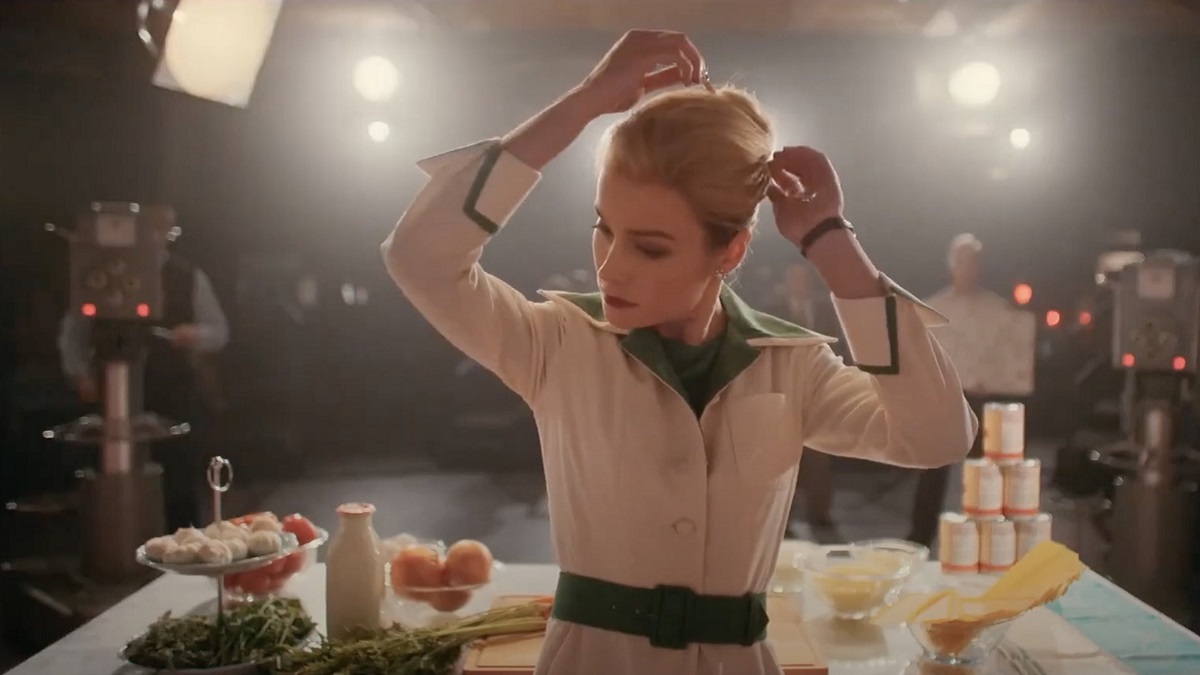Some of the most iconic characters in fiction have a specific physical trait that sets them apart from everyone else. For Harry Potter, it is his lightning bolt scar. For Superman, it is his hair curl. For Indiana Jones, it is his classic fedora. And for Elizabeth Zott in Lessons in Chemistry, it is the No. 2 pencil in her hair.
The fictional chemist turned cooking show host is brought to life by Academy Award-winning actress Brie Larson in Apple TV Plus’ adaptation of the popular New York Times bestselling novel by Bonnie Garmus. When we meet Elizabeth for the first time, she is preparing to go live for Supper at Six, the cooking show that doubles as a chemistry class for rapt viewers around the world. We don’t see Elizabeth’s face until the producer on set shouts “We’re live in five, four, three…” at which point Elizabeth stabs a pencil into her pulled-back bun, turns around, and delivers her recognizable intro:
“Welcome viewers, my name is Elizabeth Zott, and this is Supper at Six.”
Throughout the limited series’ first and second episodes, we see the No. 2 pencil in Elizabeth’s hair in some way or another. Sometimes it’s tucked behind her ear, but most of the time jabbed into her pulled-back bun.
While this may seem like an idle detail, a few ominous flashbacks in episode 1 indicate otherwise. These flashbacks occur any time someone enters a room with Elizabeth and closes the door behind them. Elizabeth doesn’t like closed doors, made evident by the death grip she maintains on her pencil anytime it happens. When Calvin Evans (Lewis Pullman) unknowingly does this at the end of episode 1, Elizabeth flies out of the room and proceeds to terminate any and all contact with him.
The real reason Elizabeth Zott keeps a pencil in her hair at all times
The following section contains spoilers for episodes 1 and 2 of Lessons in Chemistry as well as mentions of sexual assault.
At first, it comes across as a stylistic choice, perhaps something Lessons in Chemistry’s showrunner Lee Eisenberg chose to do to elevate Elizabeth’s intelligence in the eyes of at-home viewers. As we get to know Elizabeth, though, it reads more like a character trait, a practical method for keeping track of her endless stream of brilliance. However, as we progress through Elizabeth’s backstory, we understand this is more complex than just practicality. Elizabeth’s No. 2 pencil is a security blanket.
Lessons in Chemistry episode 2 opens with a flashback of Elizabeth when she was a student at UCLA in 1950 studying for her PhD. Similarly to the present day, Elizabeth’s unapologetic intelligence intimates the men around her. When the board at her qualifying exam asks her specific questions which she answers in exquisite detail, they grow silent and uncomfortable. Except for Dr. Bates, who smiles to himself similarly to the way Calvin Evans smiled to himself at the sight of Elizabeth’s unabashed intellect in the present day.
Moments later, Elizabeth is back in her office when Dr. Bates comes to congratulate her. His intentions seem pure at first but then he kisses her unprovoked, which Elizabeth rejects. That’s when he turns around and locks the door and proceeds to sexually assault her. Elizbeth fights off her attacker, eventually yanking the No. 2 pencil out of her hair and stabbing him in the abdomen.
Later she is reprimanded by a UCLA administrator and told the only way to continue her PhD is by submitting a “formal statement of regret.” This differs slightly from the book, in which Elizabeth’s story is not taken seriously by the cops who arrive on the scene, but either way, it’s just as infuriating and disheartening.
Elizabeth refuses to apologize in either scenario. Instead, she tells the UCLA administrator the only “regret” she has is “not having more pencils.”
Present-day Elizabeth is still grappling with the traumatic event. Not only does that explain why she experiences a form of PTSD if someone enters a room behind her and closes the door but also why she maintains a tight grip on her pencil in moments of high anxiety. In a world that refuses to keep her safe, she must contend with protecting herself.
